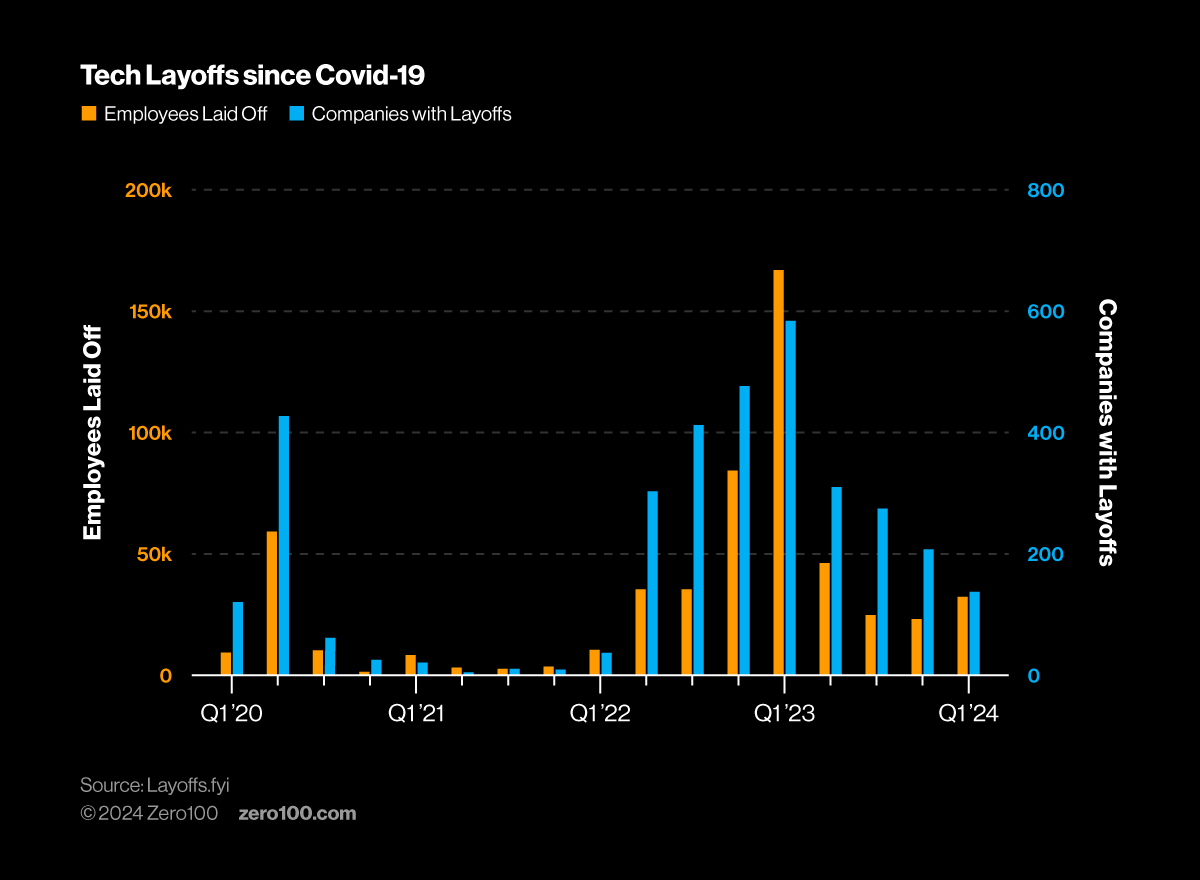Despite a strong economy and booming stock market in the US, news headlines are loaded with stories of layoffs, especially in the tech sector. Big names like Amazon, Google, Microsoft, and Salesforce have already announced new job cuts in 2024. You might think times were tough and that these companies are struggling to survive, and yet this group of four has seen their stock prices rise an average of 54.7% in the past year.

What’s going on?
Getting Back into Shape
The first part of the explanation is that many companies are still trimming positions added during the Covid/war for talent era when massive government subsidies and a sense of responsibility to employees combined to suspend normal business logic, and virtually no one was laid off. Data from Layoffs.fyi shows that tech layoffs hit 30,995 in January 2024, which was the highest in nine months, but was still well below the 89,709 cuts in January 2023. For comparison, the grand total across 21 months from Q3 2020 to Q1 2022 was only 36,961.
Surging stock prices look like a reward for getting costs under control and shifting business focus from revenue growth and lofty humanitarian aspirations back to earnings. Non-tech companies, including UPS, the Estée Lauder Companies, and Nike, have also announced plans to cut jobs with a similar intent to restructure operations and get back into fighting shape. The message to investors is that efficiency is back in vogue.
Getting Ready for the AI Era
Less obvious, but potentially more important, is a need to lay the groundwork for a revolution in the way work gets done in this era of AI. Productivity gains from early targeted uses of AI have been massive and include a 40-fold increase in idea generation among ChatGPT users (as per a study by MIT), Walmart’s use of a Pactum AI chatbot to negotiate contracts with long-tail suppliers saving its internal team thousands of work hours, and Togal.AI, which reduces the time estimators spend costing a building by over 90%. The common thread is that AI, applied precisely, can radically change the amount of human work required for certain tasks.
The effect is also relevant across business processes in a more sweeping way. McKinsey has studied the impact of generative AI on automation potential across industries and found that, on average, it will raise productivity by 25%. Their research focused on specific tasks that could be sped up with AI applications as part of a wider process redesign for efficiency.
Amazon offers a relatively mature proof point of how the AI era changes productivity in an operations-intensive business. It uses AI in forecasting, route planning, materials handling, and e-commerce sales, among hundreds of other areas. The business results through 2023 include gaining ground in both online sales and last-mile parcel delivery with a connected system of technologies that optimizes assortments, inventory placement, load building, and delivery promises.
Restructure Early and Often
The takeaway for supply chain leaders is that, going forward, layoffs are often less about cutting costs and more about breaking bad habits. Work in specific functions like contract administration is still too labor-intensive and, frankly, brain-dead for smart procurement people whose intellect is often underutilized simply because the systems haven’t been updated. The same is true for predictive maintenance in manufacturing, which lends itself to classical AI but is still too often done by experienced people whose time could be better spent tuning robotic processes than firefighting machinery glitches. These kinds of jobs were designed for an era of mass production where IT systems like ERP and PDM took years to implement and were nearly impossible to change. That era is over. Moving big chunks of application support to the cloud makes it much easier to add AI where appropriate and to continuously update as competitive conditions change.
Layoffs in this context are about restructuring not once a decade but constantly as new uses of AI are identified and rolled out for specific tasks. The best path for supply chain leaders may be leaning into it by seeking out and leading high-impact AI task overhauls.
People need to change because the work needs to change.
